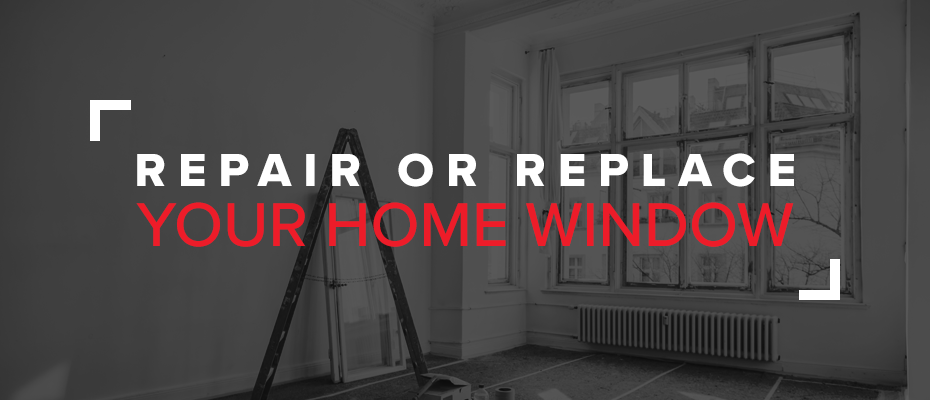
Windows are among the most important yet vulnerable features of a residential property. When problems arise with a set of windows, it is crucial to pinpoint the source of the problem and determine whether repair or replacement work will be the best option.
Determining the Problem
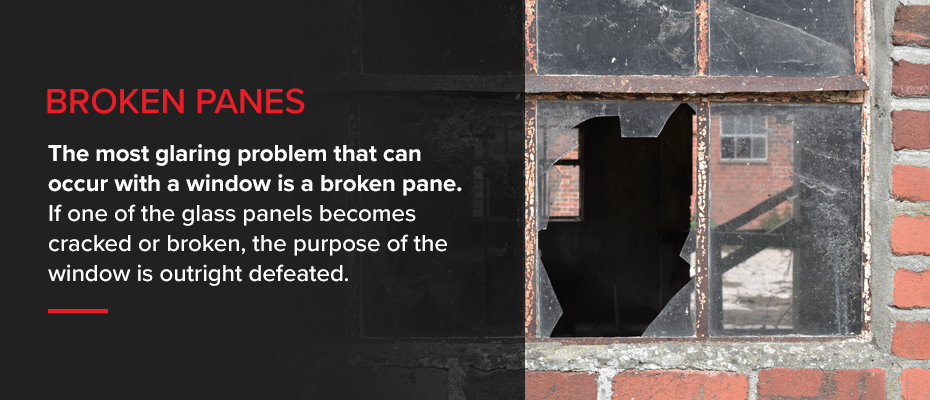
As you begin to notice issues such as wind drafts, leaks, and a loss of insulation, the problem is typically rooted in the following areas:
-
Broken Panes
The most glaring problem that can occur with a window is a broken pane. If one of the glass panels becomes cracked or broken, the purpose of the window is outright defeated. After all, the purpose of a window — aside from letting daylight into your home and allowing you to see what is happening outside — is to insulate your home from cold and heat and to protect your interior from the elements.
Once a crack appears in one of the panes, that panel of glass becomes compromised beyond salvation. If you feel cold air and loud noises coming into your home, there could be a broken pane behind the curtain.
-
Window Performance
As a window gets older, it loses its ability to insulate an interior. Problems arise as the stripping starts to wear and the seal is lost between the pane and sash. Without this seal, air can leak through the window via gaps around the outline of the pane. Worn stripping can also lead to water leakage on rainy days.
If you moved into an older home where the windows have never been replaced, worn stripping could very well be one of the main reasons for inadequate insulation. Even if you moved into a newer home, the stripping might wear somewhat prematurely if the windows are of poor quality.
-
Window Sashes
Another problem similar to worn stripping but on the outermost edges of the window assembly is a misalignment between the frame and shaft. When a window is raised and lowered repeatedly over many years, the tracking mechanisms can give way and set the frame slightly ajar. As this happens, the window will typically become harder to move up and down. This is due to the fact that the window is no longer vertically aligned. Consequently, a slight gap will form on at least one side between the window frame and sash. This problem is liable to result in lost insulation and intrusive wind drafts.
When Your Window Should Be Fixed
A window can often be salvaged when the problem is limited to one of the following factors:
-
Inoperable Sashes
If you move into an older home where the windows have not been raised in years, you might find it physically impossible to open them despite the presence of a hand crank or lock/unlock switch. In cases like these, the problem is often due to multiple layers of paint, which can form a bonding seal between the frame and sash.
Alternately, the frames may have come to squeeze the sash too tightly after years of expansion and contraction due to changing temperatures. Sashes can also become inoperable when the tracking breaks or becomes misaligned. In any case, the problem can usually be fixed.
-
Rotting Drip Cap
A window might be subjected to undue exposure to the elements if the drip cap is either worn or missing. The drip cap is the metal panel in place above the top frame on the exterior of each window. While the drip cap is normally slotted under the siding panel directly above the window, the drip cap can sometimes loosen up or wear down due to rust.
If a window has an insufficient drip cap, it could expose the panes to excess water. When combined with poor stripping, this could leave your interior exposed. Fortunately, a drip cap can usually be replaced and since it is not technically part of the window assembly, you do not need to replace a window just to replace the drip cap.
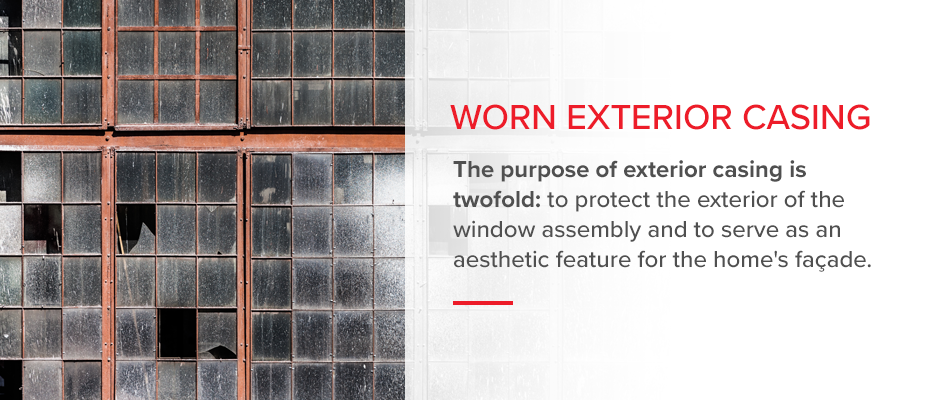
-
Worn Exterior Casing
The purpose of exterior casing is twofold: to protect the exterior of the window assembly and to serve as an aesthetic feature for the home’s façade.
Consequently, a worn exterior casing can be problematic in two ways. In terms of functionality, a poor casing could expose the window to more serious damage along the frames, sashes, and panes. From a visual standpoint, worn casing can make a house look less attractive from the outside, especially as the paint wears off and the wood starts to rot. However, a worn exterior casing can usually be removed and replaced without the need for a new window.
-
Drafty Windows
If you are feeling drafts of wind on cool days, the problem could easily be due to worn stripping or caulk along the edges of the window panes. In most cases, the problem will emerge subtly and be difficult to detect. Consequently, you might face a spike in your energy bills as you crank the heat to compensate for lost insulation.
In order to test the seals between the panes and sash of each window, light a candle and hold it along the edges of each pane. If the flame suddenly blows sideways, a wind draft is indeed present. Problems such as these can usually be rectified with new stripping or by caulking the edges of the window panes.
When Your Window Should Be Replaced
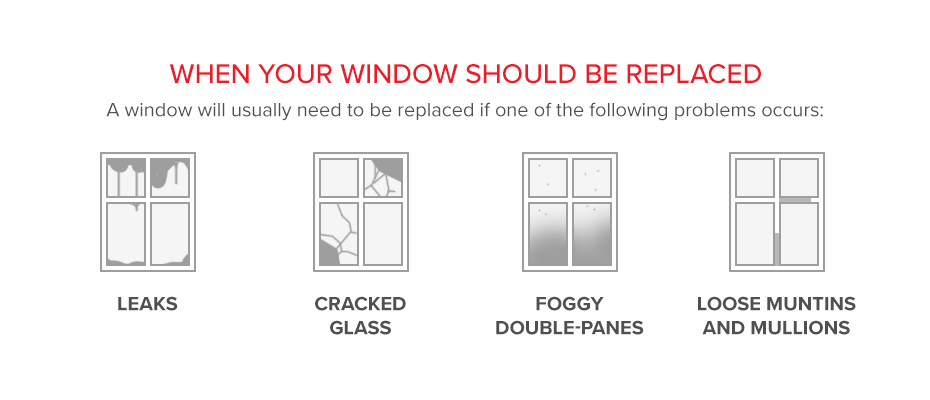
A window will usually need to be replaced if one of the following problems occurs:
-
Cracked Glass
The most urgent of window problems generally involve broken glass. If the glass is cracked or chipped in any way, there really is no way around the fact that you need new panes. If you ignore the issue for any length of time, you could leave your house vulnerable to wind, drizzle, and the invasion of insects. Even worse, a broken window pane could make your house look vulnerable from the outside, particularly in the eyes of thieves.
For obvious reasons, a cracked pane is an immediate cause for window replacement. However, you could choose to replace just the sash/pane component or the whole entire window. If the glass was cracked by a thrown ball or similar projectile and the window itself is otherwise in good condition, replace the sash and pane. If the crack is merely the latest in a long line of window problems, the time has come to buy a new window.
-
Leaks
Water leaks occur when the panes are subjected to undue quantities of water. In many cases, the problem results from poor drainage overhead. If your roof drainage system is clogged or fails to do its job properly, the water could easily leak directly down the exterior wall and onto your windows. Even though the drip cap and exterior casing are meant to protect your windows, they are only capable of handling so much water.
Window damage could be compounded by a worn drip cap or exterior casing. Alternatively, the leaks could stem from a combination of bad casing, caps, and drainage. If the problem is down to any of these factors, you could probably rectify matters by fixing the drainage tract or replacing the drip cap or casing. If the leaks continue despite these efforts, the window should definitely be replaced.
-
Foggy Double-Panes
A foggy window would generally be no problem at all unless you are dealing with inner-layer fog in a double-paned window. On contemporary double-panes — alternately known as “insulated glass units” (IGUs) — the two layers of glass are permanently bonded and thus impossible to separate. Consequently, your only choice when fog appears between the panes of an IGU is to replace the window entirely. Alternatively, you could simply replace the sash/pane component.
-
Loose Muntins and Mullions
On some but not all windows, vertical and horizontal wood bars divide each pane into four, six and sometimes eight or more squares. The thin wooden bars that split each pane into a grid are known as “muntins,” while the more frame-like bar that divides two panes is known as the “mullion.”
On some windows, the muntins and mullions are fastened to each side of a single pane of glass. Consequently, if one of the wood strips cracks, it cannot be changed out individually. Luckily, faux muntins and mullions do not impact the overall performance of a window.
On other types of window assemblies, the muntins and mullions do, in fact, encase individual panes of glass. As such, a wind draft might stem from a faint gap in the stripping between a muntin and a small pane. This problem can usually be identified with the lit-candle test. Ultimately, the problem can usually be rectified with re-caulking, especially if gaps are only present along a few edges.
What to Avoid During Your DIY
Window DIY work is not as easy as it may seem, as you could encounter the following problems without sufficient preparation and study of how such work is performed:
-
Intensive Labor
Before you attempt a home window repair and replacement, you must study the way such work is done. Otherwise, you could wind up with a frustrating mess that will lead to more money spent in short order. After all, when a window in a house or building is set into place, there cannot be any gaps between the panes, sashes, frames or wall. If even the slightest hair of a gap exists upon completion, problems such as insulation loss, wind drafts, higher energy bills and leaks are liable to result.
If you do choose to go the DIY route when you replace your windows, watch a number of videos beforehand about window installation on YouTube. Also, make sure to properly match window measurements to the window spaces on your walls before you invest.
-
Repeat Trips to the Hardware Store
When you attempt to repair or replace windows for the first time, you are liable to be under-equipped unless you stock up on supplies beforehand. In order to replace a broken window, for example, a number of tools will usually be necessary, including a cordless drill, a pry bar, an extension ladder, a tape measure and assorted finishing supplies such as casing, caulk and nails.
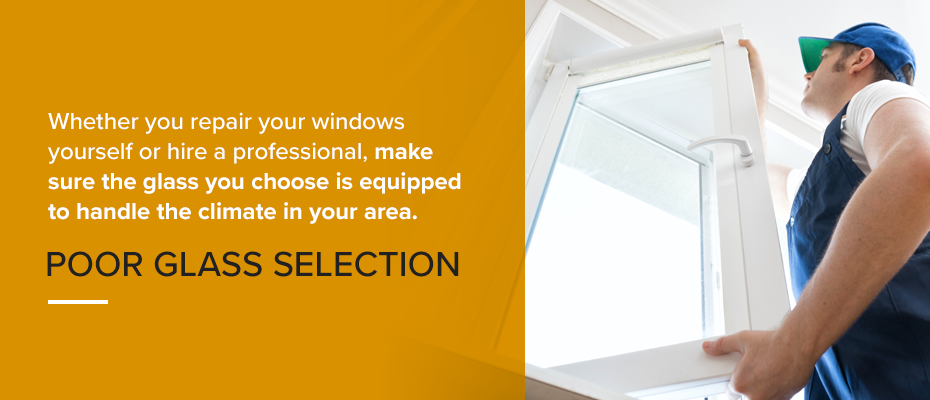
-
Poor Glass Selection
Whether you repair your windows yourself or hire a professional, make sure the glass you choose is equipped to handle the climate in your area. Today, inner-pane argon gas and low-E coatings are added to many double-pane windows to boost energy efficiency and the insulation quality of the glass itself in times of extreme coldness and humidity. Inquire about these features before you decide on a new window set.
Why You Should Hire a Professional

When you hire a professional for the installation or repair work, you are far likelier to be happy with your windows for many years to come for numerous reasons, including the following:
-
Fresh Windows
A new set of windows in your living room, bedrooms, and kitchen can give your house a facelift. If you decide to put your home on the market within the next few years, the relatively new windows could help make the property appear more fetching in the eyes of potential buyers. Even if you remain at the same house for many years to come, a new set of windows could revitalize your home internally and externally.
To make the most of the opportunity, consider a different style of windows from the ones you are replacing, as some of the new designs on the market could be more suited to your interior scheme.
-
Boosted Insulation
With a professional window installation, you can expect a significant improvement in your home’s insulation. Generally, a window that needs to be replaced will offer subpar insulation. Consequently, winters are liable to be colder and costlier due to increased HVAC energy consumption. Once you have a new window professionally installed, the problem that caused the air leak — worn stripping, loose sashes, etc. — will no longer be a factor. However, you can only ensure maximum air-tightness with the work of a professional window installer.
-
Flawless Installation
When you hire a professional for window repairs and new installations, you are most certainly guaranteed a perfect job every time. Through years of experience handling windows of all shapes and dimensions, pro installers have the art of window installation down to a science.
Fact is, the installation of windows must be done to perfection. If a measurement or placement is off by even a millimeter, the misalignment could open up gaps and allow wind, water and insects into your house. Even worse, a poorly installed window could leave your home vulnerable to burglars.
A DIY installation could result in numerous flaws that would comprise the insulation, comfort and security of your home. Even if the flaws are not readily apparent at first, you could soon find yourself back to when you first encountered problems with your window. When you consider how much is at stake regarding window insulation — comfort, insulation, security, energy bills — professional installation is the only sensible option.
-
Window Warranty
Professional window installation will be guaranteed for a generous length of time. This will give you peace of mind in knowing that if any problems arise with the insulation in the foreseeable future, you can contact the installer for maintenance free of charge. Of course, this rarely happens because the majority of professional installations do work according to plan.
The best window installers offer good warranty policies, fully confident that each customer will be satisfied. By contrast, the quality of your own DIY work is down to you and thus, a faulty installation would entirely fall on your shoulders.
For window repair and window replacement, AE Door & Window is Cincinnati’s chief supplier of residential windows in a variety of styles. Contact us today to request an estimate or schedule repair services.
